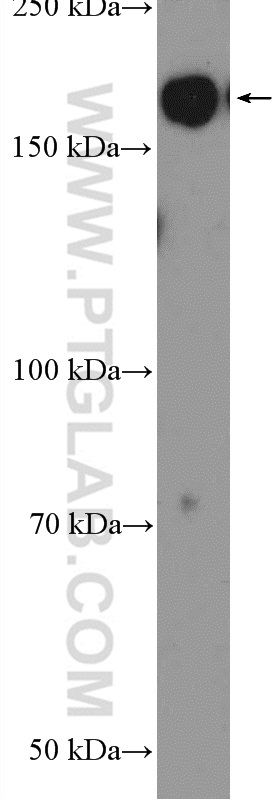验证数据展示
经过测试的应用
| Positive WB detected in | HepG2 cells |
推荐稀释比
| 应用 | 推荐稀释比 |
|---|---|
| Western Blot (WB) | WB : 1:200-1:1000 |
| It is recommended that this reagent should be titrated in each testing system to obtain optimal results. | |
| Sample-dependent, Check data in validation data gallery. | |
发表文章中的应用
| KD/KO | See 1 publications below |
| WB | See 2 publications below |
| IHC | See 1 publications below |
产品信息
25298-1-AP targets MLH3 in WB, IHC, ELISA applications and shows reactivity with human samples.
| 经测试应用 | WB, ELISA Application Description |
| 文献引用应用 | WB, IHC |
| 经测试反应性 | human |
| 文献引用反应性 | human, mouse |
| 免疫原 | MLH3 fusion protein Ag18201 种属同源性预测 |
| 宿主/亚型 | Rabbit / IgG |
| 抗体类别 | Polyclonal |
| 产品类型 | Antibody |
| 全称 | mutL homolog 3 (E. coli) |
| 别名 | HNPCC7, MLH3, mutL homolog 3 (E. coli), MutL protein homolog 3 |
| 计算分子量 | 1453 aa, 164 kDa |
| 观测分子量 | 164 kDa |
| GenBank蛋白编号 | BC112167 |
| 基因名称 | MLH3 |
| Gene ID (NCBI) | 27030 |
| RRID | AB_2880015 |
| 偶联类型 | Unconjugated |
| 形式 | Liquid |
| 纯化方式 | Antigen affinity purification |
| UNIPROT ID | Q9UHC1 |
| 储存缓冲液 | PBS with 0.02% sodium azide and 50% glycerol , pH 7.3 |
| 储存条件 | Store at -20°C. Stable for one year after shipment. Aliquoting is unnecessary for -20oC storage. |
实验方案
| Product Specific Protocols | |
|---|---|
| WB protocol for MLH3 antibody 25298-1-AP | Download protocol |
| Standard Protocols | |
|---|---|
| Click here to view our Standard Protocols |
发表文章
| Species | Application | Title |
|---|---|---|
Hum Mol Genet Lack of association of somatic CAG repeat expansion with striatal neurodegeneration in HD knock-in animal models.
| ||
Prog Neurobiol Loss of TDP-43 promotes somatic CAG repeat expansion in Huntington's disease knock-in mice |

